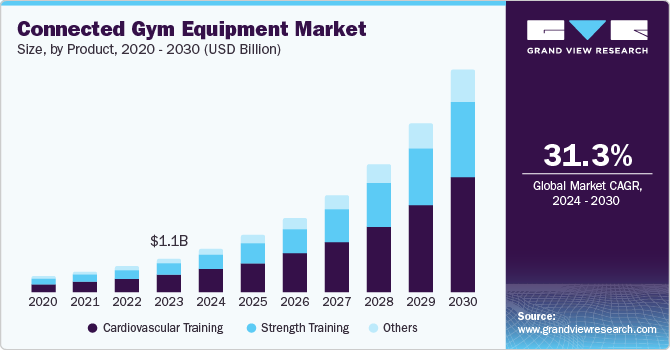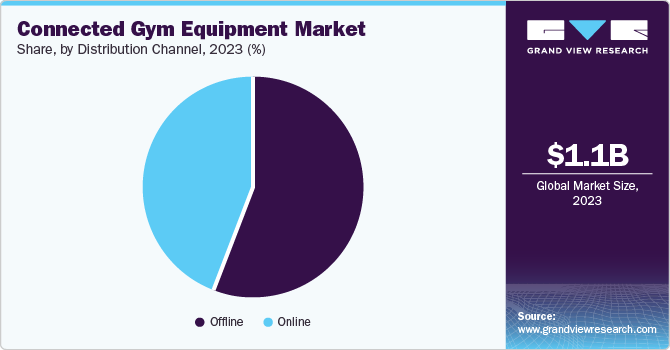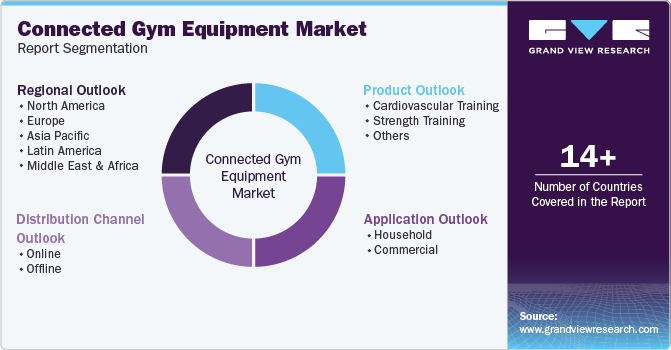
Connected Gym Equipment Market Size, Share & Trends Analysis Report By Product (Cardiovascular Training, Strength Training), By Application (Household, Commercial), By Distribution Channel (Offline, Online), By Region, And Segment Forecasts, 2024 - 2030
- Report ID: GVR-3-68038-482-6
- Number of Report Pages: 70
- Format: PDF, Horizon Databook
- Historical Range: 2018 - 2022
- Forecast Period: 2024 - 2030
- Industry: Consumer Goods
Market Size & Trends
The global connected gym equipment market size was valued at USD 1.05 billion in 2023 and is projected to grow at a CAGR of 31.3% from 2024 to 2030 The growth is owing to the rapid digitization of the health and fitness industry. As more people embraced digital solutions for their fitness needs, the demand for connected gym equipment, which integrates with smartphones and wearable devices, has significantly surged. This trend was particularly evident in regions with high smartphone penetration and internet connectivity, such as North America, Europe, and parts of Asia.

Furthermore, the heightened awareness about the importance of maintaining good health has led to an increased focus on fitness and wellness. This shift in mindset prompted more individuals to invest in home fitness equipment that could offer personalized workout experiences. Connected gym equipment, with its ability to provide real-time feedback and track progress, became a popular choice for fitness enthusiasts looking to achieve their health goals from the comfort of their homes.
In addition, the integration of advanced technologies into gym equipment played a significant role in driving market growth. Innovations such as Artificial Intelligence (AI), Machine Learning, (ML), and the Internet of Things (IoT) enabled the development of smart gym equipment that could offer tailored workout programs, monitor performance, and provide insights into users’ fitness levels. For instance, AI-powered fitness equipment analyzes users’ movements and suggests adjustments to improve their form and prevent injuries.
Moreover, the increasing popularity of virtual fitness classes and online training programs contributed to the growth of the connected gym equipment market. Many fitness brands, such as CorePower Yoga and Peloton, and gyms started offering virtual classes that could be accessed through connected devices, allowing users to participate in live or on-demand workouts from anywhere.
Additionally, the growing adoption of wearable fitness technology fueled the demand for connected gym equipment. Devices such as smartwatches and fitness trackers have increasingly become essential tools for monitoring various health metrics, including heart rate, calories burned, and sleep patterns. When paired with connected gym equipment, these wearables provide a comprehensive view of users’ fitness journeys, enabling them to make data-driven decisions about their workouts and overall health. Such synergy between wearables and gym equipment created a more cohesive and engaging fitness ecosystem.
Product Insights
Cardiovascular training held the dominant market share of 51.0% in 2023. The market growth was stimulated by the increasing awareness of cardiovascular health and the rising prevalence of lifestyle-related diseases such as obesity and heart disease. Consumers have increasingly sought to improve their heart health and overall fitness, leading to a surge in demand for connected cardiovascular training equipment, such as treadmills, stationary bikes, and elliptical machines. In addition, technological advancements including AI and IoT enabled the development of smart cardio machines that could offer personalized workout programs, real-time feedback, and performance tracking. For instance, AI-powered treadmills adjust speed and incline based on the user’s fitness level and goals, providing a more tailored and effective workout experience.
Strength training is expected to grow at a considerable CAGR during the forecast period due to the increasing popularity of weightlifting and muscle mass development. The market witnessed a significant demand for connected strength training equipment such as smart dumbbells, barbells, and weight machines with more individuals focusing on building strength and improving their physical fitness. These devices offer users precise and immediate feedback on their performance, allowing them to track their progress and make data-driven adjustments to their workouts. Additionally, the integration of connected strength training equipment with fitness apps and wearable devices significantly attracted users as they can sync their workouts with apps to receive real-time feedback, set goals, and track their progress over time.
Distribution Channel Insights
Offline distribution channels held the dominant share of 56.0% in 2023 owing to the increasing consumer preference for in-person shopping experiences. Many consumers valued the ability to physically inspect and test gym equipment before making a purchase, which offline channels such as specialty stores, department stores, and fitness equipment showrooms could provide. This hands-on experience allowed customers to assess the quality, functionality, and suitability of the equipment, leading to more informed purchasing decisions. Moreover, retail outlets provide personalized customer service including expert advice, product demonstrations, and tailored recommendations based on individual fitness goals and needs. Additionally, these channels often offer after-sales services, such as installation, maintenance, and repair, which enhance customer satisfaction and loyalty.

The online distribution channels are projected to grow at a significant CAGR over the forecast period. The market surge is attributable to the increasing accessibility and penetration of high-speed internet worldwide. With more people gaining access to reliable internet connections, the convenience of purchasing gym equipment online has become more appealing. Moreover, technological advancements in e-commerce platforms enhanced the online shopping experience, making it easier for consumers to browse, compare, and purchase connected gym equipment. Features such as virtual showrooms, detailed product descriptions, customer reviews, and easy return policies contributed to the growing preference for online purchases.
Application Insights
Commercial application held considerable market share in 2023. The growth can be attributed to the increasing number of health clubs, gyms, and fitness centers worldwide. As urbanization continued to rise, more people sought convenient and accessible fitness solutions, leading to a surge in the establishment of commercial fitness facilities. This trend was particularly prominent in emerging markets where disposable incomes and health awareness were on the rise. Moreover, many companies have increasingly recognized the benefits of promoting employee health and wellness, leading to the incorporation of fitness facilities within corporate offices.
The household segment is expected to grow at an exponential CAGR of 32.0% over the forecast period. The market was primarily driven by the increasing preference for home fitness solutions with the growing awareness of health and fitness post-pandemic. This shift was further supported by the rising costs of gym memberships and the demand for personalized fitness experiences.
Regional Insights
The North America connected gym equipment market held the largest share of 39.5% share in 2023. The market was primarily driven by the widespread adoption of advanced technologies such as AI, Virtual Reality (VR), and IoT. These innovations enabled the development of smart fitness equipment that offered personalized workout programs, real-time feedback, and immersive experiences, making them highly appealing to consumers.

U.S. Connected Gym Equipment Market Trends
The connected gym equipment market in the U.S. held considerable share in 2023 owing to increasing health consciousness among the U.S. population. With rising awareness about the importance of maintaining a healthy lifestyle and preventing lifestyle-related diseases such as obesity and cardiovascular conditions, more individuals have invested in connected gym equipment to monitor and improve their fitness levels. In addition, government initiatives promoting physical activity further supported this trend.
Europe Connected Gym Equipment Market Trends
The Europe connected gym equipment market held 32.1% of the global revenue share in 2023. The market surge can be credited to the integration of connected gym equipment with fitness apps and wearable devices. European consumers increasingly sought fitness equipment that could sync with their smartphones and wearables, allowing them to track their progress, participate in virtual classes, and connect with fitness communities online. This seamless integration created a comprehensive and engaging fitness ecosystem, making connected gym equipment more appealing to a broader audience.
Asia Pacific Connected Gym Equipment Market Trends
The Asia Pacific (APAC) connected gym equipment market accounted for a 16.7% share in 2023 owing to the rapid expansion of the fitness industry, including the increasing number of gyms, health clubs, and fitness centers. These commercial establishments have heavily invested in connected gym equipment to attract and retain members by offering cutting-edge fitness solutions.
Key Connected Gym Equipment Company Insights
Some of key participants such as Life Fitness, EGYM, TECHNOGYM S.p.A, and others. These companies have entirely focused on new technologically advancement products with increased R&D efforts, acquisitions, and mergers.
-
Draper Inc. expanded its product offerings to include custom solar control solutions, projection screens, AV lifting and mounting solutions, and gymnasium equipment. Draper Inc. serves a wide range of markets, including commercial, residential, and educational sectors, providing tailored solutions that meet the specific needs of its clients.
-
EGYM is a global leader in fitness technology and corporate health innovation. The company has developed a robust ecosystem of connected gym equipment and software designed to make workouts smarter, and more efficient.
Key Connected Gym Equipment Companies:
The following are the leading companies in the connected gym equipment market. These companies collectively hold the largest market share and dictate industry trends.
- Life Fitness
- EGYM
- Les Mills International Ltd
- TECHNOGYM S.p.A
- Precor Incorporated
- Core Health & Fitness, LLC.
- Paradigm Health & Wellness
- Johnson Health Tech
- Draper, Inc.
Recent Development
-
In March 2024, Life Fitness announced that the company was set to introduce the latest generation of cardiovascular training and strength training equipment with digital product innovations at the IHRSA Convention & Trade Show 2024. The company is expected to launch Symbio - its ultra-premium cardio line.
-
In January 2024, EGYM and Life Fitness, announced the expansion of their strategic partnership that aims to enhance the cardio workout experience by combining EGYM’s state-of-the-art fitness technology with Life Fitness’ innovative cardio equipment, offering gym-goers an enhanced exercise experience.
Connected Gym Equipment Market Report Scope
|
Report Attribute |
Details |
|
Market size value in 2024 |
USD 1.36 billion |
|
Revenue forecast in 2030 |
USD 7.00 billion |
|
Growth Rate |
CAGR of 31.3% from 2024 to 2030 |
|
Base year for estimation |
2023 |
|
Historical data |
2018 - 2022 |
|
Forecast period |
2024 - 2030 |
|
Quantitative units |
Revenue in USD million/billion and CAGR from 2024 to 2030 |
|
Report coverage |
Revenue forecast, company ranking, competitive landscape, growth factors, and trends |
|
Segments covered |
Product, Application, Distribution Channel, and Region |
|
Regional scope |
North America, Europe, Asia Pacific, Latin America, MEA |
|
Country scope |
U.S., France, Germany, China, Japan, Brazil, Saudi Arabia |
|
Key companies profiled |
Life Fitness; EGYM; Les Mills International Ltd; TECHNOGYM S.p.A; Precor Incorporated; Core Health & Fitness, LLC.; Paradigm Health & Wellness; Johnson Health Tech; Draper, Inc. |
|
Customization scope |
Free report customization (equivalent up to 8 analysts working days) with purchase. Addition or alteration to country, regional & segment scope. |
|
Pricing and purchase options |
Avail customized purchase options to meet your exact research needs. Explore purchase options |
Global Connected Gym Equipment Market Report Segmentation
This report forecasts revenue growth at global, regional, and country levels and provides an analysis of the latest industry trends in each of the sub-segments from 2018 to 2030. For this study, Grand View Research has segmented the global connected gym equipment market report based on product, application, distribution channel, and region.

-
Product Outlook (Revenue, USD Million, 2018 - 2030)
-
Cardiovascular Training
-
Strength Training
-
Others
-
-
Application Outlook (Revenue, USD Million, 2018 - 2030)
-
Household
-
Commercial
-
-
Distribution Channel Outlook (Revenue, USD Million, 2018 - 2030)
-
Online
-
Offline
-
-
Regional Outlook (Revenue, USD Million, 2018 - 2030)
-
North America
-
U.S.
-
-
Europe
-
Germany
-
France
-
-
Asia Pacific
-
China
-
Japan
-
-
Latin America
-
Brazil
-
-
Middle East and Africa (MEA)
-
Saudi Arabia
-
-
We are committed towards customer satisfaction, and quality service.
"The quality of research they have done for us has been excellent."




